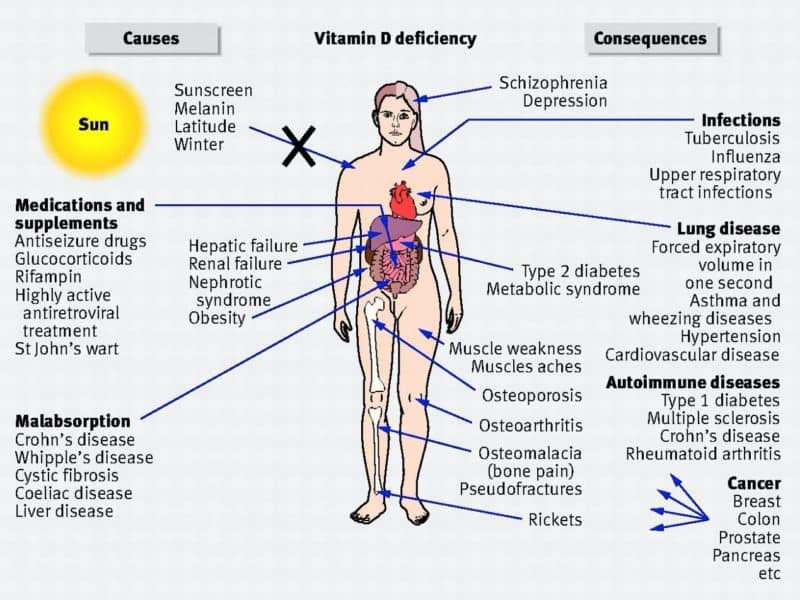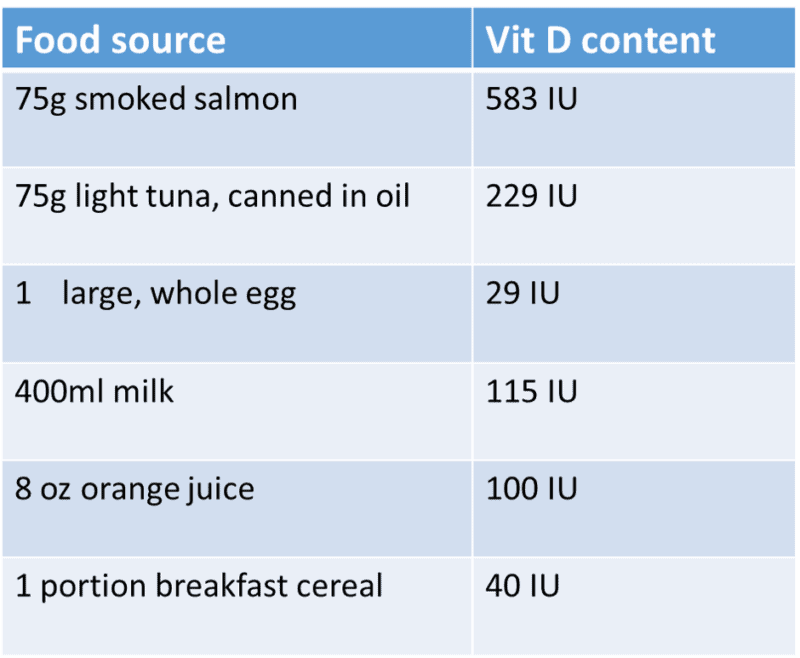Between 2005 and 2015, one third of adults tested for vitamin D deficiency in the UK were found to be deficient, according to a study published in BMJ Open. This figure is 43% among ethnic minority groups and 66% in Asians. Worldwide over a billion people are thought to be deficient.
Known as the ‘sunshine vitamin’, vitamin D is incredibly important for our bones, skin, immune system and overall health and having a deficiency can have subtle to far-reaching and detrimental effects.
In this post we’ll explore how we obtain vitamin D, why we don’t obtain enough and what we can do in order to obtain sufficient levels.
How much vitamin D do we need?
The UK Department of Health advises the following blood measurement guidelines:
- >50nmol/l = adequate
- 25-49nmol/l = insufficient
- <25nmol/l = deficient.
Your doctor can check these levels. If you are deficient your doctor will recommend:
- Eating more oily fish and eggs, which are relatively high in vitamin D
- Spending more time in the sun, when it is sunny.
- Taking a daily supplement of 10μg (400 IU) of vitamin D3. Many doctors however consider this to be insufficient and recommended a daily dose of 50μg (2000 IU).
It is worth noting that vitamin D3 is a more effective supplement than vitamin D2, which is usually what ‘vitamin D supplements’ contain unless otherwise stated.

Why do we need vitamin D?
Vitamin D increases the amount of calcium and phosphate absorbed from our food in our gut and it reduces the amount of calcium lost in our urine.
Calcium and phosphate are essentially the building-blocks of bones. Having higher levels, thanks to vitamin D, protects against osteomalacia, which is a condition where bones get soft and bendy. When osteomalacia occurs in children it is known as Ricketts and can lead to visible deformities. Having strong bones also prevents osteoporosis and stress fractures.
However, vitamin D exerts other wide-ranging effects on the body;
Vitamin D directly stimulates white blood cells to develop into specific types of infection-fighting cells, improving your immune health. Therefore, unsurprisingly, low levels of vitamin D may be linked to a higher risk of death or serious illness from the coronavirus, according to early research.
Vitamin D also influences the expression of over 1000 genes and has been shown to slow down the growth of tumour cells in the breast and colon.
Additionally, a growing number of studies point to vitamin D deficiency as a risk factor for heart attacks, strokes, high blood pressure and diabetes. An article posted by John Hopkins Medicine gives more insight into the effects of vitamin D on the cardiovascular system.
The sunshine vitamin is also been shown to improve muscle strength as well as improve the health of epithelia, which includes the skin and internal membranes, throughout the body.

How does the sun make vitamin D?
Technically it doesn’t. It causes our skin to make it.
Like most steroid hormones, vitamin D is derived from cholesterol. Cholesterol undergoes several chemical reactions to become vitamin D3 – the final product that has all these nourishing benefits we discussed.
UVB rays from the sun are required for an important reaction in this process, activating an enzyme in the skin which then converts 7-dehydrocholesterol to previtamin D3. Therefore, the sun doesn’t give us vitamin D3, instead it stimulates our skin to make it. For further details, check out this article by Dr Jennifer Robinson posted in The Food Medic.
Why are we deficient in vitamin D?
If UVB rays are not strong enough to activate the enzyme in our skin, very little vitamin D is produced. This is the case if you live somewhere with a latitude above, or below, 42.2 °N, according to a well-known 1988 study by Canadian researchers. This latitude corresponds to Boston, Massachusetts, where the study was conducted, and is equivalent to Barcelona, Spain. Here human skin exposed to sunlight on cloudless days from November through to February did not produce any previtamin D3.
Worse still, in Edmonton, Canada (52 °N) just south of Manchester, UK (53.5 °N) this ‘vitamin D winter’ lasted from October through to March. Meanwhile much further south at latitudes of 34°N and 18°N sunlight effectively activated the enzyme to convert 7-dehyrocholesterol to previtamin D3 even in the middle of winter. For reference, 34°N corresponds to Los Angeles, California and 18°N corresponds to areas of Chad, Sudan and the Dominican Republic.
Therefore, unless you’re lucky enough to escape the dreary UK winter between October and March for southern Europe, or somewhere more equatorial, the sun will not be strong enough for you to make vitamin D – you’d better be taking vitamin D3 supplements and eating some oily fish!
The good news is that on clear days in the UK, from April through to October, the sun will be strong enough to enable you to produce vitamin D. Short term exposure to this sun will avoid a deficiency. This equates to just 13 minutes a couple times a week for Caucasians, although a little longer exposure is ideal for optimal levels according to a study from the University of Manchester.
If you have darker skin, you may consider taking a vitamin D supplement of at least 10μg (400 IU) year-round because you won’t make as much vitamin D from the weak British sun. This is because melanin acts as a protective barrier against UVB rays and very dark skin may require up to 6 times more sunlight to produce the same amount of vitamin D. Therefore, you may have to increase your exposure time or venture somewhere warmer to get sufficient vitamin D from sunlight.
How to get enough vitamin D
- Spend 20-30 minutes in the British sun, a couple times a week between April and September, if you are Caucasian. If you have darker skin your sun exposure can be sensibly extended. You should not spend hours in the sun as this would increase your risk of skin cancers and sunburns.
- Take at least 10μg (400 IU) and up to 50μg (2000 IU) of vitamin D3 daily between October and March. If you have very dark skin, consider taking this supplement daily and year-round.
- Eat plenty of oily fish like tuna, mackerel and salmon; egg yolks; beef liver; cheese; foods fortified with vitamin D including orange juice, cereals and soy milk.

Why you should consider a Full Health Check Up
Vitamin D deficiency can manifest in many ways. Not only can it weaken your bones as we all know, it can also disrupt epithelial linings, including the skin inside and outside of the body. Take the lungs as an example. The delicate lining of the lungs requires adequate levels of vitamin D for optimal cell turnover and health. Additionally, a weakened immune system, resulting from this deficiency, may result in the body being less capable of identifying and fighting against infection and tumour cells. Therefore, it is likely somebody with a long-term vitamin D deficiency is at an increased risk of various illnesses.
Here at Echelon Health we can detect 92% of the diseases that lead to premature death. This figure is 95% for women. A very experienced consultant physician will assess your overall health using world-class scanning techniques and testing, resulting in the most comprehensive full body check up in London.
Request a call back
Sources
The Food Medic – What’s the deal with Vitamin D
Nature’s Best – Understanding Vitamin D Dosage



